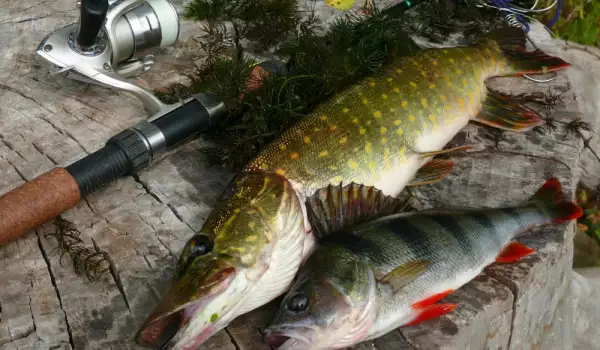Perch /Perca fluviatilis / a fish in the Bass family. It is widely used in Asia and Europe. The perch is a sustainable and unassuming predator that is already a subject of fishing.
It withstands oxygen poor waters that most fish would die in. Perch inhabit the Danube River, the lower and middle reaches of most rivers, ditches and dams. You can see it in brackish water. That makes it a primary goal of fishermen.
The body of the perch is short, laterally flattened and covered with small skin flakes. Its color varies greatly according to habitat - from pale green to olive green, sometimes almost gray. On both sides of the body of the perch, there rea five to nine black horizontal stripes. In addition, there are two dorsal fins, the first composed of spiny and the second - from softer material. The pectoral fins are yellow and the caudal and anal are red.
The perch is considered a long-liver among fish because some data on life expectancy reaches 22 to 24 years. However, it has a very slow growth rate. The maximum size of the perch that the sources mention is very controversial, as the record is considered a weight of 2.5 kg, but it is possible to have a perch of up to 4 kg.
The season for perch is from early March to mid-April in southern reservoirs and dams in the high - from early April to mid-May.

Types of Perch
Many experts determine the existence of two types of perch. The first is a small /grass/ and the second is a large /deep/. The little perch stick to year-round use of the coastal zone and grows very slowly. It feeds on invertebrates as well as small fish and fish eggs. It is claimed that it reaches a maximum weight of 200 grams
Big perch eats mostly fish that inhabit deeper areas of reservoirs and grow rapidly. For maximum weight, you can look between 1.5-3 kg.
Some believe that only certain individuals are ahead of others in their growth and thus there are significant differences in the weight of the bass. Most likely a small perch is just behind in its development.
Composition of perch
The perch is rich in potassium, sodium, vitamin A, B6, B12, B5, It is composed of histidine, niacin, cysteine, aspartic acid, glutamic acid, glycine and others.
100 g of raw perch contains 114 calories, 18 g protein, 3.7 g fat, 0 g carbohydrates, 70 mg sodium, 356 mg potassium, 200 mg phosphorus, 12.6 mg selenium, 80 mg calcium, 1 mg vitamin B5, 2 mg of vitamin C, 75 ml water.

Selecting and storing Perch
Choose perch that has clear and healthy-looking eyes. Cloudy eyes are a sign of long-caught fish. Perch, like many other types of fish, should be cooked immediately or at the latest the day after purchase, because it is not very durable. Store it in a refrigerator. When freezing, the meat preserves its taste qualities for 3-4 months.
Perch in cooking
Perch has translucent flesh, with superb taste. The problem arises when it is cleaned. If you do not wish to skin it, should be cleaned on the spot, almost while still alive, or immerse it in boiling water.
After cleaning the perch, only small fillets will remain, which are pure white meat without bones and the characteristic odor of fish. As it became clear, the meat that remains is not much, so it's nice to eat mostly fried in a lot of fat or to make soup. If you're not a fan of fried food, you can bake it in the oven. Perch is used for fillets or canned.
Benefits of perch
Consumption of perch has many health benefits. It is useful for the skin and mucous membranes of the digestive and nervous systems. Regulates levels of sugar in the blood and is an excellent source of antioxidants. Its flesh contains large quantities of phosphorus and phosphoric acid, which participates in the construction of numerous enzymes- key drivers of chemical reactions in cells. The meat of the bass is low in fat, which makes it suitable for dietary regimes and against obesity.
















